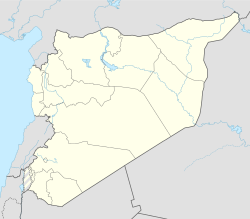Jubb'adin (Western Neo-Aramaic: ܓܦܥܘܕ - גפעוד Ġuppaʿōḏ lit. 'the well of Eden or the well of Audius',[2] Arabic: جبعدين)[3] is a village in southern Syria, administratively part of the Rif Dimashq Governorate, located northeast of Damascus in the Qalamoun Mountains. Nearby localities include Saidnaya and Rankous to the southwest, Yabroud and Maaloula to the northeast, and Assal al-Ward to the northwest.
Jubb'adin
ܓܦܥܘܕ - גפעוד جبعدين | |
|---|---|
Village | |
| Coordinates: 33°49′35″N 36°30′33″E / 33.826382°N 36.509215°E | |
| Country | |
| Governorate | Rif Dimashq |
| District | al-Qutayfah |
| Subdistrict | Maaloula |
| Population (2004 census)[1] | |
• Total | 3,778 |
| Time zone | UTC+2 (EET) |
| • Summer (DST) | UTC+3 (EEST) |
| Area code | 11 |
According to the Syria Central Bureau of Statistics, Jubb'adin had a population of 3,778 in the 2004 census.[1] However, that number has likely decreased during the Syrian Civil War as a result of combat casualties and emigration. The village's inhabitants are all Sunni Muslims by religion and of Aramean (Syriac) descent.[4][5][6][7][8][9][10][11][12][13] Following their conversion to Islam in the 18th century, the inhabitants of Jubb'adin underwent a religious transformation, shifting from being exclusively Christian to entirely Muslim.[14][15]
The village is among the two last remaining villages where Western Neo-Aramaic is still spoken. Most of the younger people in the village are bilingual and speak both Western Neo-Aramaic and Syrian Arabic fluently. Jubb'adin is the main source of modern poetry written in the Western Neo-Aramaic language, thanks to its many poets. The environment is colder than in most other Syrian cities and villages due to its altitude.[16]
The main mosque in the village is called Jemʿa rāb "the Large Mosque" in Western Neo-Aramaic.
Etymology
editThe etymology of the village's name remains controversial. It is believed to be composed of two parts. The first part is Ġuppa "well" (Western Neo-Aramaic: ܓܘܦܐ) and the second part is ʿōḏ (Western Neo-Aramaic: ܥܘܕ), which could mean 'Eden', making the name to mean "the well of Eden".
Another possibility is that it is a reference to Audius, who founded Audianism, a sect of Christians in the 4th century which were founded in Syria, in which case it would mean "the well of Audius". Another theory, though less likely, is that the word is a reference to the people of ‘Ad, who are mentioned in the Quran.
References
edit- ^ a b General Census of Population and Housing 2004. Syria Central Bureau of Statistics (CBS). Rif Dimashq Governorate.(in Arabic)
- ^ Abou-Ismail, Anas (2020). Western Neo-Aramaic: The Dialect of Jubaadin. Cambridge Scholars Publishing. p. 2. ISBN 978-1-5275-5046-9.
Its Aramaic name is ġuppaҁōḏ, which is how its natives refer to it, while the word Jubaadin is the Arabized form of its name.
- ^ AntonSamuel (11 September 2017). "English: Maaloula 7". Commons.wikimedia.org. Retrieved 3 December 2017.
- ^ Abū al-Faraj ʻIshsh. اثرنا في الايقليم السوري (in Arabic). Al-Maṭbaʻah al-Jadīdah. p. 56.
السريان في معلولا وجبعدين ولا يزال الأهلون فيها يتكلمون
- ^ iنصر الله، إلياس أنطون. إلياس أنطون نصر الله في معلولا (in Arabic). لينين. p. 45.
... معلولا السريان منذ القديم ، والذين ثبتت سريانيتهم بأدلة كثيرة هم وعين التينة وبخعا وجبعدين فحافظوا على لغتهم وكتبهم أكثر من غيرهم . وكان للقوم في تلك الأيام لهجتان ، لهجة عاميّة وهي الباقية الآن في معلولا وجوارها ( جبعدين وبخعا ) ...
- ^ Rafik Schami (25 July 2011). Märchen aus Malula (in German). Carl Hanser Verlag GmbH & Company KG. p. 151. ISBN 9783446239005.
Ich kenne das Dorf nicht, doch gehört habe ich davon. Was ist mit Malula?‹ fragte der festgehaltene Derwisch. >Das letzte Dorf der Aramäer< lachte einer der…
- ^ Yaron Matras; Jeanette Sakel (2007). Grammatical Borrowing in Cross-Linguistic Perspective. De Gruyter. p. 185. doi:10.1515/9783110199192. ISBN 9783110199192.
The fact that nearly all Arabic loans in Ma'lula originate from the period before the change from the rural dialect to the city dialect of Damascus shows that the contact between the Aramaeans and the Arabs was intimate…
- ^ Dr. Emna Labidi (2022). Untersuchungen zum Spracherwerb zweisprachiger Kinder im Aramäerdorf Dschubbadin (Syrien) (in German). LIT. p. 133. ISBN 9783643152619.
Aramäer von Ǧubbˁadīn
- ^ Prof. Dr. Werner Arnold; P. Behnstedt (1993). Arabisch-aramäische Sprachbeziehungen im Qalamūn (Syrien) (in German). Harassowitz. p. 42. ISBN 9783447033268.
Die arabischen Dialekte der Aramäer
- ^ Prof. Dr. Werner Arnold; P. Behnstedt (1993). Arabisch-aramäische Sprachbeziehungen im Qalamūn (Syrien) (in German). Harassowitz. p. 5. ISBN 9783447033268.
Die Kontakte zwischen den drei Aramäer-dörfern sind nicht besonders stark.
- ^ Prof. Dr. Werner Arnold (2006). Lehrbuch des Neuwestaramäischen (in German). Harrassowitz. p. 133. ISBN 9783447053136.
Aramäern in Ma'lūla
- ^ Prof. Dr. Werner Arnold (2006). Lehrbuch des Neuwestaramäischen (in German). Harrassowitz. p. 15. ISBN 9783447053136.
Viele Aramäer arbeiten heute in Damaskus, Beirut oder in den Golfstaaten und verbringen nur die Sommermonate im Dorf.
- ^ "Hilfe für das Aramäerdorf Maaloula e.V. | an aid project in Syria".
- ^ Shannon Dubenion-Smith; Joseph Salmons (15 August 2007). Historical Linguistics 2005. John Benjamins Publishing Company. p. 247. ISBN 9789027292162.
…Western Neo-Aramaic (Spitaler 1938; Arnold 1990), which is attested in three villages whose speakers just a few generations ago were still entirely Christian.
- ^ Wolfhart Heinrichs (14 August 2018). Studies in Neo-Aramaic. Brill. p. 11. ISBN 9789004369535.
The inhabitants of Bakh'a and Jubb'Adin are Muslims (since the eighteenth century), as is a large portion of the people of Ma'lula, while the rest have remained Christian, mostly of Melkite (Greek Catholic) persuasion. The retention of the "Christian" language after conversion to Islam is noteworthy.
- ^ Amar, Joseph (12 October 2012). "The Loss of Syria". Commonwealmagazine.org. Retrieved 22 December 2012.
External links
edit- Samples of spoken Western Neo-Aramaic at the Semitisches Tonarchiv (Semitic Audio Archive)
